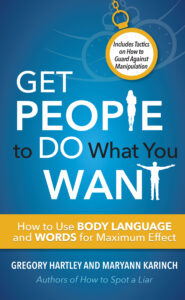Understanding Motivation
What makes people tick. I’ve always been fascinated by people’s motivation. Why does one person react one way and another completely different to the exact same thing? And how do you best influence others given our differences.
Enter Greg Hartley, former US ARMY Interrogator, Body Language Instructor, and author of 10 books on body language and behavior. Greg’s latest collaboration with Maryann Karinch focuses on human drives, manipulation, countering manipulation, and influence. Their newest book, Get People to Do What You Want: How to Use Body Language and Words for Maximum Effect, hits on some of the questions I always ask. And so I was fascinated to ask Greg more about his interrogation work and research.
You have an incredible background, written numerous books, conducted numerous seminars, but I hear that you also were featured in Cosmopolitan magazine several times. That’s not a likely career accomplishment from a United States army interrogator. How did that happen?
I always say I have followed my nose through a life that has been interesting with many turns. After I left the army I went into a corporate job and a mutual friend with Maryann pushed me to write. He introduced me to the best writer he knew and we developed a partnership that is now 15 years old. One of our books “Date Decoder,” a dating book for women, connected me with Cosmopolitan and Marie Claire for articles on reading people mostly as it relates to relationships and conflict.
You talk about several tools ranging from questioning to body language to active listening that are important. Give us a sense of these and their importance.
Non-Coercive Interrogation is nothing more than a set of Extreme Interpersonal Skills that allow the intelligence collector to get more information quicker. These skills center around understanding why a person does something, tapping into their drives and ways of communicating, and getting cooperation. People want to be listened to and not just heard. Their messages often include elements that go unobserved by an untrained person. These skills work wonderfully to make a person feel safe and get cooperation. The skills work well in the corporate environment, social settings, and even with perfect strangers to get what the person is both saying and not saying quicker.
Leadership and the Study of Body Language
Why is the study of body language and motivation important for leaders?
Go back and look at the last presidential election with the sound off. Who did you believe? Either of them? The power to project a clear message that looks and feels genuine is the first reason, the ability to perceive what is and is not being said back, and whether you are trusted is the other. Trust comes from congruent messages in word, tone, cadence, and body language. While most of us cannot put words to what we are seeing in body language, we do know who we trust. If you as a leader can tap into that trust, you can be much more effective.
What’s a baseline and why is this important?
There are some common misconceptions in body language. Examples are people who do not look you in the eyes are lying, or people who cross their arms are shutting you out. A person’s communication style is as unique as their fingerprint. If you start from a flawed premise like when someone folds their arms they are lying, you will get the wrong message. Baselining teaches you to create a model for that person’s communication style and to look for change in messaging instead of an absolute that may not apply.
Watch for these Words
A big focus of your book is also words. What are some verbal tipoffs that should cause you to pause?
Words like “and then” or “after that” indicate skipping time in a story. This may mean nothing or could be omitting pertinent facts. I also listen for shifts in pronoun from I to we to indicate blame sharing. Shifts in tense can indicate a deviation from the main story. If a person is telling a story in the past tense and suddenly switches tense to present I want to know why.
Any tips to recognize when you are being manipulated?
If someone seems entirely too focused on you and you feel good when they are around but not so good when they are not, you should be suspicious.
What tactics can a leader use to type people and recognize what attracts them and what repels them?
Active listening tells you what a person cares about: people emphasize words that matter in a sentence. Often this emphasis may seem out of place or extreme. Patterns of words that come up again and again are pointing to what the person cares about. Pay attention, listen, nod and they will give you more information.
People open up to things they are interested in, both figuratively and physically, their eyes open wide, chins rise, and they remove barriers from between themselves and things they are attracted to. When a person isn’t interested, body language does the opposite, leaning away, creating barriers, less attention, eyes more closed and less energy.
Let me ask this. “Fill in the blank. If there was one thing that I would want everyone to be aware of from reading my book, it would be ____.”
We are all affected by the need to belong to a group and then show others how good we are at something. That means we all are susceptible to group dynamics. If you learn how to recognize these drives, control your own reaction, and recognize the impact of other people, you can take control of your life.
With your training, are you ever able to relax or are you constantly evaluating every situation and speaker in terms of veracity and intent?
When I first started the journey, it was tough to turn off. I thought every scratch or sniff had meaning and then with time I learned that a scratch may be an itch. I have learned to turn it off and only turn it on when I have a trigger that makes me suspicious of someone. I think the best indicator this is working for me is in social settings. My wife will often find a person she believes is being deceptive and say, “turn on your tools and talk to John.”
Interrogation Tools
How did you learn this?
The tools in this book are a lifetime of learning. After interrogating and teaching interrogation, I left the “business” for a corporate career. I noticed the same behaviors outside intelligence and started to analyze why the tools worked. While what we discuss in this book is certainly driven by my background in the intelligence world, it took me twenty years to go past the techniques used in the interrogation room and investigations and boil it down to these simple processes. The tools work in everyday life because the tools are based on core human behaviors. If you read this book and say, “I knew that,” I think we have done what we set out to do with the book.
How has your understanding of these tools changed through the years?
In the past people needed to be cognizant of the impact of others in their lives and vigilant to how that impacted their psyches mostly when they were in public. In today’s world, EVERYTHING is public. You cannot unplug. These tools and processes play out all your waking hours today. Life is in that way harder than in the past when you could simply avoid contact.
For more information, see Get People to Do What You Want: How to Use Body Language and Words for Maximum Effect.

